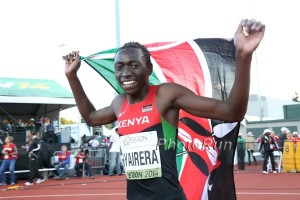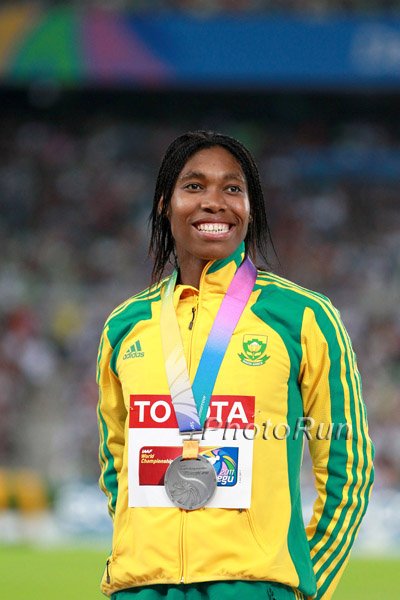A Brief History of Intersex Athletes in Sport
By Joanna Harper, Guest Columnist
September 19, 2014
This summer, there have been two separate incidents involving the issue of intersex women and track and field. On July 15, Indian sprinter Dutee Chand was barred from competing in the Commonwealth Games by the Sports Authority of India after her androgen levels were revealed to be too high for her to compete as a female. Then, nine days later in Eugene, Ore., 17-year-old Margaret Wambui of Kenya won gold in the women’s 800 meters at the World Junior Championships amidst speculation that she may be intersex.
Some people are under the misconception that these are isolated incidents. They are not.
Sports, and track and field in particular, have a long history with intersex women. But before I get into that, I should give an overview of exactly what it means to be intersex. Intersex people were once called hermaphrodites, but that term is now considered pejorative. The term DSD (Differences of Sexual Development) is often used to describe intersex conditions.
Just like the rest of us, intersex people get assigned a gender at birth when a doctor looks between their legs and says boy or girl. If the choice isn’t clear, the doctor will consult with the parents and make a decision. More often than not, intersex children will continue to live as the gender assigned at birth, but a gender shift later in life is not uncommon.
There are two DSDs with a significant impact on women’s sports. These are androgen insensitivity syndrome, or AIS, and five alpha reductase deficiency, or 5-ARD. In each case, babies are born with the Y chromosome normally associated with maleness, but with mutations that often cause them to be assigned into the female gender. Despite outward appearances, however, people with either of these DSDs will not develop internal female organs due to the influence of the Y chromosome. Instead, their gonads will develop as testes, and they may or may not form other internal male organs.
AIS people have a mutation which prevents testosterone (T) from being absorbed by the body; hence there will be plenty of T in the blood, but virtually none in other cells. Those with AIS usually look like any other woman from the outside. Since there is no T uptake in the body, any athletic advantage they might have over other women is very small.
Those born with 5-ARD have a mutation which prevents the creation of dihydrotestosterone, or DHT, in the body. DHT is a powerful androgen which triggers the formation of male genitalia. Thus, 5-ARD babies are often assigned female gender. Unlike AIS people, however, those with 5-ARD are affected by the T in their system and become much more masculine at puberty. This can give them a very large athletic advantage over other women.
Women were first allowed to participate in track and field at the Olympic Games in 1928, and the first intersex athlete of note in the sport, Stella Walsh, won gold in the 100 meter sprint in 1932. It was not known that Walsh was intersex until after her death in 1980.
Concern over intersex athletes, and the possibility that men might masquerade as women, led to gender testing in track and field. From 1968 until the 1990s, all women in international competition were tested to ensure they had two X chromosomes. Those that didn’t were banished. María José Martínez-Patiño was a Spanish hurdler in the eighties. When she discovered that she had a Y chromosome, she decided to challenge the established rules. She knew she was a woman and that she deserved to be able to compete as one. She found medical and scientific allies who convinced sports federations that her AIS posed no threat to other competitors, though unfortunately too late for her to compete in the Olympics.
After the Patino affair, the IAAF and IOC discontinued chromosome-based gender testing, but still tested women sporadically on the basis of suspicion until the Caster Semenya case rocked the sports world in 2009. Semenya exploded onto the scene that year as an 18-year-old, winning the 800 meter race at the World Championships by a huge margin of 2.45 seconds. Her manly build and deep voice, combined with the ease of her victory sparked outrage among her fellow athletes.
It was rumored that her T levels were high, and that the IAAF wanted her to undergo a gonadectomy to remove her testes. It was further rumored that she refused surgery but agreed to chemical means to lower her T to female levels. She resumed racing a year later, eventually wining silver medals at the 2011 Worlds and 2012 Olympics.
The IAAF and IOC had to come up with a better policy than the ad hoc one they had used over the previous fifteen years. They convened experts and decided to use functional testosterone as the deciding factor to determine eligibility for women’s sport (the IAAF adopted these rules in 2011; the IOC adopted them in 2012). Any woman whose T was too high would have to lower it (by surgery or drugs) if they wanted to continue to compete in the female division. Since the T in the blood of AIS women is not functional, they can compete with no alterations.
In order to fully understand this new ruling, it is necessary to look at some numbers. The normal T range for men is 10-35 nmol/L (nanomole per liter), with an average in the low twenties, and for women it is 0.35-2.0 nmol/L, with an average of about 1.5. The IAAF chose to set the maximum level for women at the nominal male minimum of 10 nmol/L.
This decision has serious implications for all female athletes. Higher T is an advantage and no typical female will get anywhere close to 10 nmol/L without doping. Thus, the agency has set a bar for the dopers, and they will aim for it.
Blood testing is needed in order to determine absolute T levels, and the IAAF ruled that all athletes must be be blood-tested as part of the biennial World Championships. In addition, any athlete can be blood-tested, at any time, as part of the biological passport system designed to catch dopers.
The agency also became more open about the history of their testing; published papers revealed that the IAAF had completed five gender-based investigations between 2006 and 2011, during the period of ad hoc testing. Since 2011, at least 18 women have been found to have T above 10 nmol/L. Six of those cases were drug-related. Eight of the others have a DSD, of which four have 5-ARD.
Those four athletes were the subject of a paper published in April 2013 in The Journal of Clinical Endocrinology & Metabolism (you can read the paper here). The paper explains that all four were advised to undergo a gonadectomy, and were told that they could continue to compete after surgery. All four agreed to get the surgery. These cases were handled discreetly; I heard no rumors surrounding any of them.
Prior to surgery, the average T level of the four with 5-ARD was around 21 nmol/L, only very slightly below male average and well above the cutoff mandated by the IAAF for women competitors. After a typical gonadectomy, average T level is almost exactly one, which is below that of an average female. This means the athletes will have gotten stunningly slower after surgery; I estimate about 20 seconds per mile. This speed reduction would change a world-class athlete into a decent national-caliber one.
On the other hand, if an athlete opted for reducing her T chemically, she could stay just under 10 nmol/L, the IAAF limit. The speed loss would be markedly smaller. Armed with this knowledge, I assume most athletes would choose chemical means to lower T. Perhaps someone warned Semenya about the effects of a gonadectomy, and perhaps this influenced her choice to go the chemical route.
The other thing to consider is the reaction of the athletes who have had gonadectomies. The temptation to dope in order to regain their careers would be very strong; in fact, one of the eight DSD cases mentioned above was also one of the six doping cases.
I’m sure that many readers would be skeptical about the loss of speed after surgery, but I have no doubt. You see, I’ve been there. I’m transgender; I competed for many years as male, then had surgery and competed as female afterwards. I went from running a 37-minute 10K as a 46-year-old man to a 42-minute 10K as a 48-year-old woman.
Let’s return to those two cases I mentioned in the introduction. Until a month ago, Dutee Chand was a rising international-caliber sprinter for India. The 18-year-old is the current national 100 meter champion and earlier this year won two gold medals at the Asian junior championships. She was selected to run in the Commonwealth Games until a blood test revealed that her T levels were too high to allow her to compete. Despite the fact that they are charged with maintaining confidentiality for their athletes, the Athletic Federation of India released her test results to the media. Back in 2006, the same people revealed the intersex status of 800 meter runner Santhi Soundarajam, which resulted in Soundarajam attempting to commit suicide.
The Sport Authority of India has suggested that Chand should be allowed to compete regardless of her natural T levels. The SAI plans to appeal to the Court of Arbitration for Sport if the IAAF rules that Dutee needs to lower her T in order to compete. One important aspect of this case is that the IAAF may not have even finished the investigation that is triggered by a high T measurement. It is also possible that Chand might have AIS and that the IAAF would let her back into competition without any modification.
Rumors continue to swirl about Wambui; she has not competed since winning gold in Eugene.
The inclusion of intersex athletes in women’s sports inevitably raises enormous issues regarding fair play for the majority, and compassionate treatment for the minority (Martínez-Patiño, the Spanish hurdler with AIS, addresses some of those issues here). I would like to look a little more closely at these issues in a second piece.
Joanna Harper is a medical physicist working and running in Portland OR. She ran a 2:23 marathon as “a young man”, and has won six age group national titles as “an old lady”. She is currently writing a book on gender variance in sport. Questions, comments? Post them on our running messageboard or email the author.


